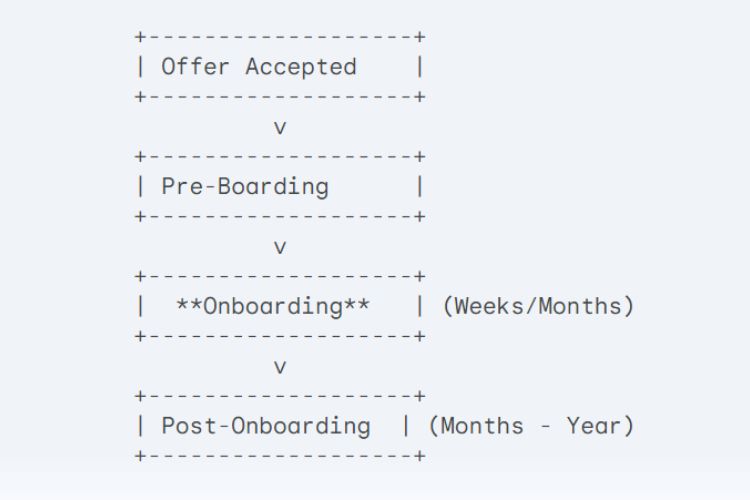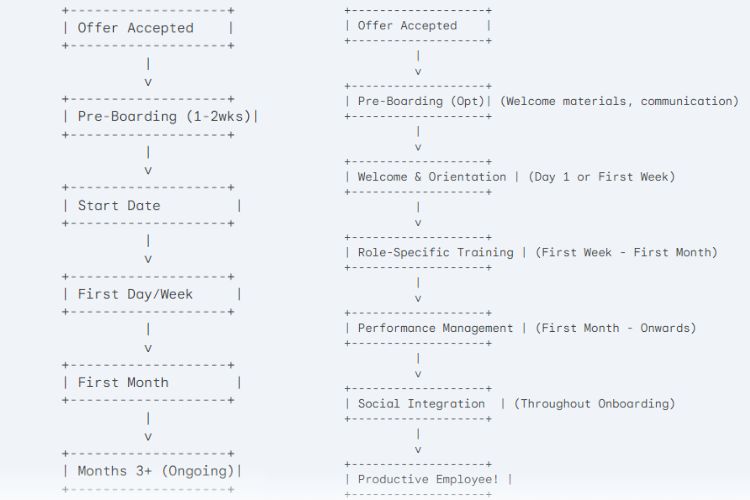Struggling to retain top talent? Learn how to design an onboarding program that gets your new hires up to speed and excited to contribute!
In today’s competitive job market, attracting top talent is only half the battle; retaining those high performers is even more crucial for long-term success. A well-designed onboarding process is your secret weapon in the current war for talent – it’s the bridge that takes new hires from enthusiastic novices to engaged and productive team members. This article will equip you with the knowledge and strategies to craft a winning program that sets your new hires up for success from day one!
(by Jonathan M. Pham)
Highlights
- Onboarding is a process that enables new hires to get acclimated to the company culture, expectations, and their role – while equipping them with the necessary knowledge and skills to succeed. A well-structured program boosts new hire confidence, reduces stress, and fosters a collaborative environment by providing clear expectations, relevant training, and open communication channels. On an organizational level, it contributes to fostering team spirit, reinforcing company culture, improving productivity & retention, and strengthening employer branding.
- Onboarding goes beyond equipping new hires with tools to include others such as knowledge transfer, performance management, social integration, development opportunities, and compliance training. The process’ main steps include welcoming new hires, integrating them into the company and their role, and providing ongoing support for their success.
- Ineffective onboarding efforts – characterized by unclear expectations, logistical hurdles, poor communication, and lack of ongoing support lead to high new hire turnover. To ensure engagement, companies need to follow a structured framework, adopt a personalized approach, focus on positive experiences & learning, and commit to continuous improvement.
- An employee’s journey within a company extends beyond onboarding to include transitions within it (crossboarding), departures (offboarding), and returns (reboarding).
- Moving forward, the onboarding process is expected to undergo trends such as technology (remote onboarding, AI, VR), bite-sized learning, collaboration, and data-driven personalization.
What is Onboarding?
Onboarding (also known as “organizational socialization”) refers to the process of integrating a new employee (sometimes called “new hire”) into an organization. It’s about helping them get settled in and up to speed on everything they need to know to be successful in their new role – and make a positive contribution to the team.
As part of the talent acquisition process, onboarding typically involves several activities to equip the new member with the necessary knowledge, skills, and behaviors – and to help them understand the organization’s culture, expectations, as well as their specific roles within the company. These include:
- Introduction to the company’s mission, vision, and values.
- Overview of company policies and procedures.
- Completion of administrative tasks like paperwork and setting up the workspace.
- Training sessions related to the job role.
- Meetings with key team members and managers.
- Setting up goals and performance expectations.
- etc.

Onboarding vs Orientation
Onboarding and orientation are both essential steps in integrating a new employee into a company, but they serve different purposes. Here’s a breakdown of the key differences between them:
| Feature | Orientation | Onboarding |
| Summary | One-time welcome event |
Long-term integration process
|
| Focus | Basic introduction (company, policies, culture) |
Job-specific skills & knowledge, ongoing support
|
| Format | Group setting (in-person or online) |
Personalized, one-on-one interactions
|
| Activities | Company presentations, paperwork, office tours, meet-and-greets |
Job training, mentorship, goal setting, performance reviews
|
| Duration | Day(s) |
Weeks, months, or even a year
|
In short, orientation is like the appetizer – it gives you an initial taste of the company. On the other hand, onboarding is the main course – it combines the former with other activities like training, socialization, and integration – so that the new hire is best equipped to become productive and thrive in their role.
The Importance of the Onboarding Process in HR
An effective onboarding process is a win-win for both companies and new hires:
Benefits for employees
- Increased confidence and abilities
It is a tendency for new hires to feel overwhelmed by a new job. A well-structured onboarding program introduces them to the company culture and familiarizes them with the tools they will be using. This reduces uncertainty and makes them feel more comfortable in their role.
Onboarding typically includes training sessions that equip one with the specific skills they need to perform their job effectively. This could involve learning new software, analyzing company processes, or developing industry-specific knowledge. With a strong foundation of knowledge in place, new hires may then integrate into the team more quickly, and become able to start contributing to projects sooner.
- Improved employee experience
A structured plan lays out what’s expected of a member during their first weeks or months. This clarity eliminates confusion and the frustration of not knowing what to do or who to ask. At the same time, it also ensures that processes such as filling out paperwork, setting up accounts, and learning the ropes are organized and efficient – which helps save valuable time and reduces the initial stress of a new job.
Investing time and effort into onboarding demonstrates the organization’s commitment to the employee. This contributes to a sense of belonging and sets a positive tone for their experience at the company.
- Better awareness of the bigger picture
A well-defined job description isn’t enough. Onboarding clarifies specific expectations for the new hire’s role, including key performance indicators (KPIs) and how their work aligns with the team’s objectives. Additionally, a detailed process establishes communication channels for the new hire to ask questions, seek clarification, and receive feedback. This fosters a culture of open communication, ownership, and collaboration.

Benefits for companies
- Strengthened team dynamics
Activities that involve interaction with colleagues, like team lunches or coaching/ mentoring programs, foster social connections and a sense of camaraderie, which make new hires feel like part of the team from day one. By providing constructive feedback early on, managers may assist the employee in getting used to their role and establishing strong working relationships with colleagues. The result is increased collaboration, trust, and overall team success.
- Stronger company culture
Onboarding is the ideal time to introduce new hires to the company’s core values – what they truly mean, plus stories of employees who have embodied them, etc. As such, it sets the stage for employee success, promotes a sense of belonging, and ensures everyone is working towards the same goals – all contributing to a more positive and productive workplace.
- Higher productivity & retention rate
Various studies have shown that well-onboarded employees are more likely to stay with the company, thereby reducing costly turnover and related resources (e.g. retraining costs). As pointed out in Gallup’s research, those who feel engaged and valued become less likely to look for opportunities elsewhere. On the other hand, low engagement may cause a whooping 43% increase in turnover rate.
In another study published in the Harvard Business Review, it is observed that a standardized onboarding process is capable of enhancing new-hire productivity by 62% and retention by 50%.
- Contributing to employer branding
Happy and engaged employees are more likely to become brand ambassadors for their company – by sharing their experiences on social media, professional networks like LinkedIn, or even through word-of-mouth recommendations. As a result, the company’s image in the eyes of potential candidates should be significantly improved.
In today’s digital age, many job seekers rely on employer review sites like Glassdoor or Indeed to get a sense of a company’s work environment. A positive onboarding experience translates to glowing reviews on these platforms, highlighting aspects like supportive colleagues, clear communication, and a focus on employee well-being. This positive online reputation will contribute to the attraction of top talent seeking a great place to work.
- Building up the talent pool
Through training programs and initial projects, organizations may identify individuals with high potential who might be suitable for future leadership roles or specialized development programs. Early identification allows for investment in these people’s growth, grooming them for future vacancies within the company.
When employees feel valued and supported by the company, they are likely to become advocates for their organization. Their referrals further contribute to the expansion of the talent pool with qualified candidates who already have a positive impression of the company culture.
Read more: Employee Engagement in the Digital Age – Strategies for Powering Up Your Workforce

Types of Onboarding
There are several different types of onboarding, each focusing on a specific aspect of the process:
- Operational onboarding: The most basic level, its goal is to ensure the new hire is equipped with everything they need to do their job. Activities include setting up their workspace, obtaining equipment and software access, and completing necessary paperwork.
- Knowledge onboarding: Providing the employee with the specific knowledge and skills required for their role via training programs, access to resources/ documentation, and mentorship from experienced colleagues.
- Performance onboarding: Setting clear expectations and goals by establishing short-term milestones, providing regular feedback, and offering opportunities to demonstrate one’s abilities.
- Social onboarding: Activities that are meant to make the new hire feel welcome and integrated into the team. Examples include team lunches, buddy programs, social events, and opportunities to connect with colleagues outside of work.
- Talent onboarding: Providing opportunities for growth and advancement, offering challenging tasks, and encouraging participation in special projects – with the goal of identifying and refining one’s competencies for optimal performance.
- Compliance onboarding: Covering legal and policy-related information that one needs to be aware of in their new role.
Onboarding Process for New Employees – Main Stages & Steps
-
Preboarding (Offer acceptance – Start date)
This stage begins as soon as the new hire accepts the offer. The focus is on keeping them engaged and prepared for their first day.
Typically, the first phase is made up of the following steps:
- Welcome package: Send a welcome email or package with company swag and information to get the new hire excited.
- Pre-paperwork: Electronically collect necessary paperwork (e.g., tax forms) for completion before the start date.
- Schedule overview: Provide a tentative schedule for the first week, including who they will meet and what to expect.
- Equipment setup: Ensure the new hire’s workspace is set up with the necessary equipment and software access.
-
Onboarding (First day – Weeks/months)
Moving forward, we enter the intensive period of integrating the new employee into the company and their role.
First day:
- Welcome and introductions: Make the new hire feel welcome with a warm greeting and introductions to key team members and colleagues.
- Workspace tour: Introduce them to their workspace, IT setup, and resources.
- Company overview: Provide an overview of the company’s mission, vision, values, and culture.
- Manager meeting: Schedule a meeting with the manager to discuss expectations, goals, and the role in detail.
First week:
- Department orientation: Introduce the new hire to their specific department, team members, and workflows.
- Role-specific training: Begin role-specific training programs, including software tutorials, product knowledge, and departmental processes.
- Mentorship introduction: Connect the employee with a mentor who can provide ongoing guidance and support.
First month(s):
- Continued training: Provide ongoing learning and development opportunities based on the role and the employee’s needs.
- Performance check-ins: Schedule regular check-ins with the manager to discuss progress, address questions, and provide feedback.
- Social integration: Facilitate opportunities for the new hire to connect with colleagues through team lunches, social events, or buddy programs.
-
Post-onboarding (Months – Year)
This ongoing stage focuses on continued support, feedback, and development for the new employee.
- Performance feedback & development: Provide ongoing opportunities for feedback, growth, and development through performance reviews, skill-building programs, and challenging assignments.
- Continued support: Maintain open communication channels and ensure the new hire feels comfortable seeking help or guidance when needed.
Here’s a simplified flowchart to visualize the process above (this is just a general framework – the specific steps and components will vary depending on your company and the role).

More specific, customized flowcharts:

Challenges of Employee Onboarding
According to Gallup’s research, only 12% of new hires believe that the onboarding process at their company is good. In fact, many people decide to quit within the first few months – which presents an issue for organizations to find a solution to.
Employee onboarding initiatives may fail for a number of reasons, often due to a lack of planning, structure, and clear communication. Here’s a breakdown of some of the most common challenges and mistakes:
- Lack of a formal process
A study by CareerBuilder reveals that up to 36% of new hires feel that companies lack a structured onboarding process – which causes them to feel lost and confused, thereby hindering their ability to integrate and become productive quickly. On the other hand, various organizations make the mistake of not involving the managers in the initiatives – and leave them solely to the HR department.
- Ambiguous expectations
If new hires don’t understand their role and what’s expected of them, it can lead to frustration and a feeling of being set up to fail. On the other hand, bombarding them with too much information at once also results in counterproductive effects.
- Disorganized paperwork and logistics
A cumbersome process for completing paperwork, setting up equipment, or obtaining access to systems will just give rise to unnecessary stress.
- Neglecting socialization & company culture
Onboarding is about more than just HR administrative tasks – it’s about integrating the new employee into the whole company experience. Failure to do so will cause feelings of isolation and hinder their sense of belonging.
- Training discontinuation
Onboarding is an ongoing process, not a one-time event. New hires need continued support and development beyond their first day or week.
- Manual processes
Reliance on paper-based forms or manual data entry is a slow and inefficient approach that no longer works in the modern business landscape. Utilizing onboarding software can streamline the process and free up time for more personalized interactions.
- Remote onboarding challenges
Onboarding remote employees presents unique difficulties and requires extra effort from the company to ensure they feel connected and engaged.
What Makes a Good Onboarding Process?
A good onboarding process goes beyond just paperwork and introductions. It’s a strategic and well-designed program that effectively integrates new hires into the company and their role. Here are some of its key elements:
- Structured framework
Having a well-defined framework with clear stages (pre-boarding, onboarding, post-onboarding) and specific steps within each phase ensures a smooth and organized experience for new hires. Additionally, proactive and consistent communication keeps them informed, reduces anxiety, and fosters a sense of connection.
- Personalized focus
Imagine Sarah, a new graphic designer, starting at a marketing agency. Her onboarding program includes tutorials on the company’s design software and project management tools, but it also dives deeper into the agency’s specific design style and branding guidelines. This personalized approach shows Sarah that her unique skills and contributions are valued, and it equips her to succeed in her specific role.
In the example above, we see how tailoring the program to Sarah’s role (graphic designer) and needs (learning the agency’s design style) demonstrates the company’s investment in her as an individual – which results in a more engaged and productive team member. On the other hand, setting clear goals and providing regular feedback enables them to understand expectations, track their progress, and feel supported in their development.
- Positive experience
An effective employee onboarding process goes beyond just logistics (like benefits and IT setup); rather, it’s about making new hires feel welcome and supported – and about showcasing a positive workplace culture that empowers and makes them feel like part of the team. As such, organizations need to invest in connecting them with experienced mentors, creating opportunities for them to have meaningful interactions with others, and reinforcing their values via activities such as workshops, events, and team retreats.
- Learning
A survey by LinkedIn has revealed that 94% of employees would stay longer if they feel that the company is actively investing in their learning & development. To reduce the likelihood of new hires quitting after onboarding, it is crucial that companies find ways for them to develop professional skills and advance in their desired career path. Aside from formal training sessions, on-the-job training should also be considered a crucial factor.
- Continuous improvement
Regularly soliciting feedback from new hires and tracking onboarding metrics allows organizations to identify areas for improvement and ensure effectiveness. Additionally, they need to make sure that their initiatives are adaptable to accommodate changes within the company, new technologies, or evolving roles.
For example, let’s say a software company has just onboarded new engineers with a program that includes training on their coding technologies and project management tools. After a few months, they follow up with these members through surveys and one-on-one meetings – and learn that some struggle to learn a specific new coding language that wasn’t initially part of the onboarding process. In response, the company adds supplementary training in this language to their plan. This feedback loop ensures new engineers are equipped with the most up-to-date skills they need to succeed, improving their overall experience and the company’s productivity.
Read more: Employee Skill Development – How to Boost Your Bottom Line
Tips for Effective Employee Onboarding
Below are a few best practices to help design an onboarding program that contributes to enhancing employee engagement:
- Start early: Reach out personally to the new hire before their first date. This could be a call, email, or even a handwritten note from their manager.
- Structured schedule: Provide a clear itinerary for the first week, outlining who they will meet, what they will learn, and what to expect each day. Additionally, schedule a dedicated catch-up with the manager to discuss expectations, and goals, as well as to answer any questions the new hire may have.
- Social activities: Plan social events or team lunches for them to better connect with colleagues outside of work settings. According to research by the Harvard Business Review, factors such as socialization and authenticity can cause an increase of up to 33% in terms of talent retention and customer satisfaction.
- Incorporate job shadowing: Allow new employees to shadow their colleagues to gain hands-on experience and better understand their roles.
- Involve leadership: Have senior leaders take part in the onboarding process.
- Celebrate milestones: Acknowledge and celebrate the new hire’s achievements, big or small, to boost morale and keep them engaged.
- Career path discussions: Discuss their career aspirations and potential growth paths within the company.
- Technology integration: Utilize technology to streamline onboarding tasks, deliver training materials, and facilitate communication.
Read more: Train the Trainer Model – Investing in Excellence

Onboarding Metrics
Engagement metrics:
- New Hire Net Promoter Score (NPS): This metric, similar to the NPS used for customers, measures a new hire’s willingness to recommend the company to others based on their onboarding experience.
- Time to Proficiency: How long it takes for a new hire to reach a specific level of productivity in their role.
- Completion Rates of Training Programs: The percentage of new hires who complete assigned onboarding training modules.
- Employee Engagement Surveys: Regular surveys can gauge new hires’ overall satisfaction with the onboarding process and their level of engagement with the company.
Retention metrics:
- New Hire Turnover Rate: The percentage of new hires who leave the company within a specific timeframe (often within the first year).
- First-Year Retention Rate: The percentage of those who are still with the company after their first year.
Performance metrics:
- Quality of Work: Evaluate the quality of work produced by new hires after they have completed onboarding.
- Customer Satisfaction Scores (if applicable): How they are driving customer satisfaction.
Bonus:
- Time to Complete Onboarding: How long it typically takes one to complete the onboarding program.
- Number of Support Tickets: The number of support tickets submitted by new hires during onboarding, which can indicate areas where they may need additional assistance.
Onboarding Checklist
Below is an onboarding checklist template that can be used as a starting point to develop a comprehensive program for new hires. You can tailor the content to the specific needs of your company and the roles you are hiring for.
Pre-Boarding (Offer Accepted – Start Date):
- Welcome Package: ✔ Send a welcome email or package with company swag and information about the company culture, benefits, and start date.
- Pre-Paperwork: ✔ Collect necessary paperwork electronically (e.g., tax forms) for completion before the start date.
- Schedule Overview: ✔ Provide a tentative schedule for the first week, including who they will meet and what to expect.
- Equipment Setup: ✔ Ensure the new hire’s workspace is set up with the necessary equipment and software access (computer, phone, etc.).
First Day:
- Welcome & Introductions: ✔ Greet the new hire warmly and introduce them to key team members and colleagues.
- Workspace Tour: ✔ Introduce them to their workspace, IT setup, and resources (printer, break room, etc.).
- Company Overview: ✔ Provide an overview of the company’s mission, vision, values, and culture.
- Manager Meeting: ✔ Schedule a meeting with the manager to discuss expectations, goals, and the role in detail.
- Benefits & HR Overview: ✔ Explain company benefits, policies, and procedures (vacation time, health insurance, etc.).
- IT Login & Security Training: ✔ Provide login credentials and conduct basic IT security training.
First Week:
- Department Orientation: ✔ Introduce the new hire to their specific department, team members, and workflows.
- Role-Specific Training: ✔ Begin role-specific training programs, including software tutorials, product knowledge, and departmental processes.
- Mentorship Introduction: ✔ Connect the new hire with a mentor who can provide ongoing guidance and support.
First Month(s):
- Continued Training: ✔ Provide ongoing training and development opportunities based on the role and the employee’s needs.
- Performance Check-Ins: ✔ Schedule regular check-ins with the manager to discuss progress, address questions, and provide feedback.
- Social Integration: ✔ Facilitate opportunities for the new hire to connect with colleagues through team lunches, social events, or buddy programs.
Additional Considerations:
- Onboarding Tasks: Include specific tasks for each stage of onboarding with deadlines for completion (e.g., completing online training modules).
- Resource List: Provide a list of key resources for new hires, such as the employee handbook, IT support contact information, and benefits website.
- Feedback Mechanism: Build in a way for new hires to provide feedback on their onboarding experience throughout the process.
Onboarding Tools & Software
There are various onboarding tools and software options available to streamline the onboarding process, improve communication, and enhance the new hire experience. Here’s a breakdown of some common categories:
- Applicant Tracking Systems (ATS)
These systems can be used to manage the entire recruitment process, including sending offer letters and collecting pre-boarding paperwork electronically.
Examples: Greenhouse, BambooHR.
- Onboarding Management Platforms
Dedicated onboarding software helps automate tasks, create workflows, and track the progress of new hires throughout the onboarding journey. They can also be used to deliver training materials, manage documents, and facilitate communication.
Examples: Workday Onboarding, BambooHR Onboarding, Rippling.
- E-Learning Platforms
Platforms that are designed to create and deliver online training modules, quizzes, and other learning materials for new hires.
Examples: LearnDash, Moodle, Kajabi.
- Communication & Collaboration Tools
Project management tools, video conferencing software, and instant messaging platforms that facilitate communication and collaboration between new hires, managers, and colleagues during onboarding.
Examples: Slack, Microsoft Teams, Zoom.
Read more: Enhancing Team Productivity with the Right Software

FAQs
How long does onboarding take?
The length of the process may vary depending on several factors, such as:
- Company size and complexity: Larger organizations with more complex structures may require a longer duration.
- Job role and seniority: Senior or specialized positions may necessitate more extensive onboarding compared to entry-level roles.
- Industry: Certain industries, like finance or healthcare, may have stricter compliance or regulatory training requirements that potentially extend the duration.
Most HR professionals recommend a minimum of three months for onboarding – so that new hires may gain a solid foundation in the company culture, their role, and essential skills. That said, even after that, the process may continue lasting up to a year, to ensure that employees feel supported and engaged in the long term.
How do I tailor onboarding to different audiences/ positions?
An effective onboarding program caters to the specific needs of different audiences and positions. Here’s how to customize it:
- Role-specific onboarding: Develop targeted training programs and tasks aligned with the specific skills and knowledge required for the role. For example, an onboarding initiative for a marketing specialist would involve different elements compared to a software engineer.
- Experience level: For senior hires, the process may focus on cultural integration and understanding company strategy, while entry-level positions may need more foundational training on core processes and company tools.
- Learning preferences: Consider offering a variety of learning methods like online modules, hands-on training, or mentorship programs to cater to different learning styles.

Beyond Onboarding: Crossboarding, Offboarding, and Reboarding
Onboarding sets the foundation for a new hire’s success, but it’s just the first step in the employee lifecycle. Here’s a look at three other important stages:
Crossboarding:
- Definition: The process of transitioning an employee within the same company to a new role or department.
- Why it’s important: Even for internal moves, employees need to be integrated into the new team, understand their role, and be equipped for success.
- Tips:
- Leverage existing knowledge and skills from the previous role.
- Provide targeted training specific to the new role and responsibilities.
- Facilitate introductions and connections within the new department.
- Offer support and guidance throughout the transition period.
Offboarding:
- Definition: The process of formally ending an employee’s relationship with the company, whether due to resignation, retirement, or termination.
- Why it’s important: A well-managed offboarding process helps mitigate risks, ensure a smooth handover of responsibilities, and maintain a positive relationship with the departing employee.
- Tips:
- Conduct exit interviews to gather feedback on the employee experience.
- Collect company property (laptop, badge, etc.).
- Secure access to company systems and data.
- Clearly communicate the employee’s last day and next steps.
- Consider offering post-employment benefits.
Reboarding:
- Definition: The process of re-integrating a returning employee back into the company after a leave of absence. This could be due to parental leave, sabbatical, or medical leave.
- Why it’s important: The workplace may have changed during their absence. Reboarding helps them get reacclimatized and ensures a smooth transition back to their role.
- Tips:
- Provide updates on company changes, policies, and procedures.
- Offer refresher training on relevant job skills and tools.
- Reconnect them with colleagues and re-establish their networks within the company.
- Address any concerns or challenges they may have about returning to work.
By effectively managing these different stages, organizations may have a much better chance of improving employee engagement, transferring knowledge, and ensuring a smoother overall employee experience throughout their time with the company.
The Future of Onboarding – New Key Trends
Onboarding is expected to be shifting towards a more tech-enabled, personalized, and data-driven approach. By embracing the following trends, companies may be better equipped to deliver engaging experiences that set new hires up for success, improve retention rates, and foster a positive and productive work environment.
- Remote onboarding: With the rise of remote work, online onboarding has become essential. This involves utilizing video conferencing, online training modules, and collaboration tools to effectively integrate remote employees.
- Artificial Intelligence (AI) and chatbots: AI-powered chatbots can answer new hires’ questions 24/7, provide basic information and resources, and help them navigate the onboarding process. They may also help personalize the experience by recommending relevant training materials based on the new hire’s role and learning style.
- Virtual Reality (VR) and Augmented Reality (AR): VR and AR technologies have the potential to create immersive onboarding experiences. Imagine a new engineer virtually walking through a manufacturing plant or a salesperson practicing pitches in a simulated customer interaction.
- Microlearning & gamification: Short, bite-sized learning modules and gamified elements can make onboarding more engaging and interactive, especially for millennials and Gen Z.
- Social & collaborative learning: Online forums, knowledge-sharing platforms, and peer-to-peer learning opportunities are expected to rise in terms of popularity. They help foster a sense of community and collaboration among new hires, even in a remote setting.
- Data-driven insights: Leveraging data analytics to track onboarding progress, identify areas for improvement, and personalize the experience for future hires.
- More complicated metrics: Companies will move beyond tracking simple completion rates and delve deeper into measuring engagement, knowledge retention, and the impact of onboarding on key performance indicators (KPIs).
- Focus on employee experience: Onboarding is all about creating a positive and engaging experience for new hires from day one. This means organizations must go beyond just the administrative tasks and focus on making them feel welcome, valued, and supported.
- Soft skills development: Onboarding programs are going beyond technical skills training to integrate skills development like communication, collaboration, and problem-solving.
Read more: Talent Transformation – Building a High-performing, Future-ready Workforce

Final Thoughts
By investing in a well-structured onboarding program, you’re not just setting new hires up for success, but are also laying the foundation for a more productive, engaged, and positive work environment for everyone. We hope that the strategies and techniques outlined in this guide will equip you with the necessary foundation to continuously improve your talent strategies and stay ahead of the curve in this ever-evolving business world.
Other resources you might be interested in:
- Talent Management: Mastering the Basics for Success
- Organization Development (OD): A Closer Look
- HR Business Partner (HRBP): Bridging HR & Business for Remarkable Results
- Team Coaching: Guidelines for High Performance

